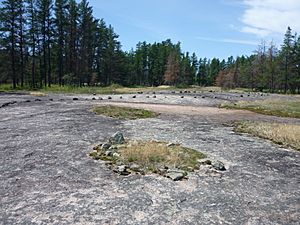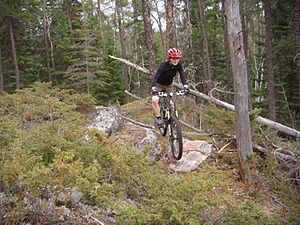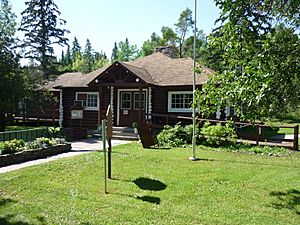Whiteshell Provincial Park facts for kids
Quick facts for kids Whiteshell Provincial Park |
|
|---|---|
|
IUCN Category II (National Park)
|
|

Whiteshell River within the park
|
|
| Location | Manitoba, Canada |
| Nearest city | Winnipeg, Manitoba |
| Area | 2,721 km2 (1,051 sq mi) |
| Established | 1961 |
| Governing body | Government of Manitoba |
Whiteshell Provincial Park is a huge natural area in southeast Manitoba, Canada. It's about 120 kilometers (75 miles) east of Winnipeg. This park is a special protected place, covering about 2,752 square kilometers (1,063 square miles).
The park helps protect the beautiful forests and lakes of the Lake of the Woods area. It's part of a larger natural region called the Boreal Shield. Whiteshell also protects the Tie Creek basin, which is a very important place for Indigenous peoples.
Contents
Whiteshell Provincial Park: A Manitoba Adventure
A Look Back: Park History
Whiteshell Provincial Park became a provincial park in 1961. It was one of the first parks created after Manitoba passed its Provincial Parks Act. People started visiting the area more often after railway lines were built in the late 1800s and early 1900s.
In 1927, some people thought Whiteshell should be Manitoba's first national park. However, another park, Riding Mountain National Park, was chosen instead.
Ancient Connections: Indigenous Heritage
The Ojibway people and other Indigenous groups lived in this area for thousands of years. The park's name comes from the cowrie shells used in ceremonies by the Anishinaabe people, including the Ojibway. The Winnipeg River and Whiteshell River are important waterways that flow through the park.
Indigenous peoples used this land for many things. They harvested wild rice, hunted, fished, traded, and held ceremonies. They also taught their children and lived here. In 1734, Pierre Gaultier de Varennes, sieur de La Vérendrye was the first European to explore the area. He was looking for a route to the Pacific Ocean.
Whiteshell Provincial Park has many pink granite rocks. These rocks were used by First Nation peoples to create petroforms, which are shapes made by arranging stones. Scientists have also found signs of ancient copper trading and stone tool making here. The copper trade started about 6,000 years ago. Many old artifacts and campsites have been found and are protected by law. Indigenous peoples still use the park today for wild rice harvesting and ceremonies.
Around 1920, new roads made it easier for tourists to visit Whiteshell. The first summer cottages were built near the railway lines. In 1922, a smaller park called Brereton Lake Dominion Park was created. This park later became part of the Whiteshell Forest Reserve in 1930. More roads were built, connecting the area to Ontario and to new campgrounds.
Exploring the Park: Rivers and Lakes
Three main rivers flow through Whiteshell Provincial Park, creating many beautiful lakes. The Winnipeg River forms the northern edge of the park. It flows west through lakes like Numao, Nutimik, Dorothy, Margaret, and Natalie.
The Whiteshell River enters the park from the southeast. It connects lakes such as West Hawk Lake, Caddy Lake, Jessica Lake, White Lake, and Betula Lake. This river eventually joins the Winnipeg River. The Rennie River is another waterway that links Shiaro Lake, Jean Lake, Brereton Lake, Rice Lake, and Heart Lake. It then joins the Whiteshell River. Falcon Lake is in the southern part of the park, and Big Whiteshell Lake is one of the largest lakes in the north.
Your Visit to Whiteshell Park
Whiteshell Provincial Park is located right on Manitoba's border with Ontario. If you're driving into Manitoba from the east on the Trans-Canada Highway, you'll enter the park first. Other highways, like Highway 44, also run through the park.
You usually need a vehicle permit to enter Manitoba Provincial Parks all year round. You can buy these permits at campgrounds, park offices, or online.
Many people visit the park in the summer. Some families own cottages here, which they rent from the government. Staying at these seasonal homes is often called 'cottaging'. If you don't have a cottage, you can rent one or stay at a lodge or resort.
The park has ten campgrounds that are open from May to October. You need to make reservations for these sites. The cost depends on what facilities and services are available.
Fun in the Sun: Summer Activities
- Boating – You can launch your boat at many lakes. Some resorts also rent boats.
- Canoeing and kayaking – The park has over 325 kilometers (200 miles) of canoe routes. On the Caddy Lake route, you can paddle through tunnels cut into rock by old railways!
- Sailing and boardsailing – Falcon Lake and West Hawk Lake have sailing clubs.
- Fishing – There are many different kinds of fish to catch in the park's waters.
- Swimming – You can swim at public beaches and near many lakeside cottages.
- Hiking – Trails range from short 1.5-kilometer (1-mile) walks to the challenging 60-kilometer (37-mile) Mantario Trail. Part of the Trans-Canada Trail is also in the park.
- Cycling – There are bike trails at Betula Lake and Big Whiteshell Lake. The South Whiteshell Trail is a multi-use path that connects Falcon Lake to Caddy Lake.
Winter Wonderland: Cold Weather Fun
- Icefishing – You can try fishing through the ice on the frozen lakes.
- Snowmobiling – The park has over 200 kilometers (124 miles) of marked and groomed snowmobile trails.
- Snowshoeing – When it snows, you can explore the trails and frozen lakes on snowshoes.
Discovering North Whiteshell
You can reach the northern part of the park by road from the west. There are also train stops at Brereton Lake, Ophir, and Winnitoba station served by Via Rail's Canadian train.
Campgrounds in North Whiteshell include Otter Falls, Nutimik Lake, Betula Lake, White Lake, Big Whiteshell Lake, and Brereton Lake.
Whiteshell Natural History Museum
The Whiteshell Natural History Museum opened in 1960. It's in a log building and shows off local animals through mounted displays. You can also learn about the boreal forest, Canadian Indigenous peoples, petroforms, and the Winnipeg River. The museum is located at Nutimik Lake. It has been closed since 2018.
Alfred Hole Goose Sanctuary
The Alfred Hole Goose Sanctuary and Interpretive Centre is a special place that protects nesting Canada geese every spring. The center teaches you about geese and the sanctuary's history. You can watch the geese from an observation gallery and join interpretive programs.
Whiteshell Trappers Museum
The Whiteshell Trappers Museum is next to the Goose Sanctuary. Built in 1997, it looks like a fur trapper's cabin. Here, you can learn about the history of fur trapping, different trapping methods, and local wildlife.
Exploring South Whiteshell
You can get to the south side of the park from the Trans-Canada Highway. The main entrance is near Falcon Lake. Falcon Lake has two campgrounds, a beach, a golf course, a ski resort, and other tourist services.
Campgrounds in South Whiteshell include Caddy Lake, Falcon Beach, Falcon Lakeshore, and West Hawk Lake.
West Hawk Lake is the deepest lake in Manitoba. It was formed by a meteorite hitting the Earth! It's a popular spot for scuba diving, even in winter.
West Hawk Museum
The West Hawk Museum is located at West Hawk Lake. It has exhibits about the area's geology, gold mining, and how the lake was formed by a meteorite impact.
Whiteshell Fish Hatchery
At the Whiteshell Fish Hatchery Interpretive Centre, you can learn how they raise fish like lake sturgeon, trout, and walleye. These fish are used to stock lakes all over Manitoba. The hatchery is open during the summer months.
Amazing Animals of Whiteshell
Whiteshell Provincial Park is home to many different animals. Large mammals include black bears, moose, white-tailed deer, timber wolves, and lynx. Smaller animals like river otters, martens, fishers, red foxes, beavers, and red squirrels also live here.
Many birds fly through the park, such as owls, bald eagles, hummingbirds, chickadees, blue jays, osprey, loons, ducks, and Canada geese. You might also see snakes, turtles, and many kinds of insects. The lakes and rivers are full of fish like perch, walleye, jackfish, lake sturgeon, trout, and smallmouth bass. A special fish called mooneye is smoked and sold as "Winnipeg goldeye."
Gallery
See also
- List of protected areas of Manitoba
- List of provincial parks in Manitoba
- Park ship












